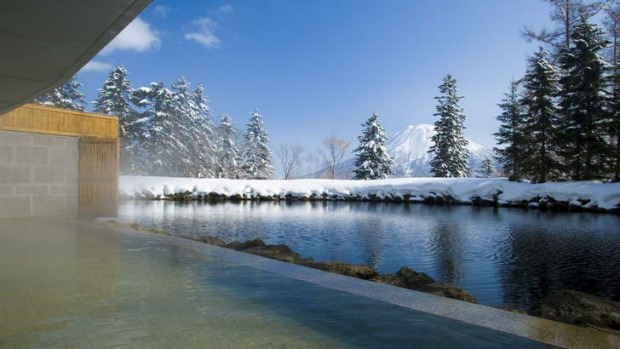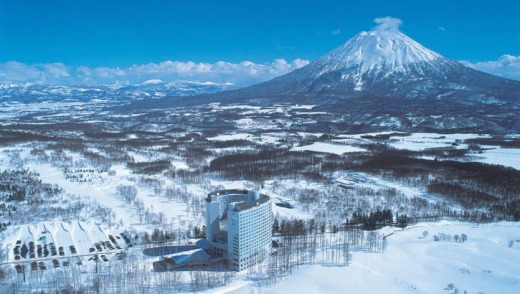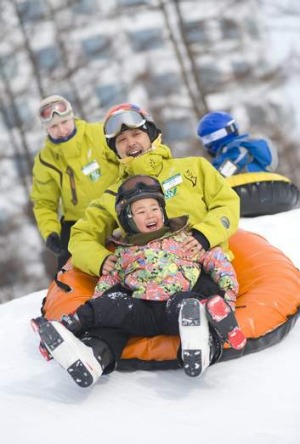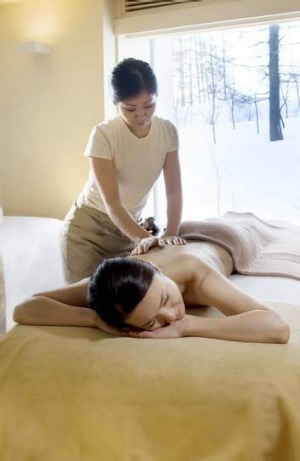
World-class conditions, sophisticated apres ski options and affordable passes. Guy Wilkinson revels in Japan's snow playground.
There's sometimes a perverse enjoyment derived from fear. Not the truly paralysing, heart-stopping kind; more a sense of being on edge that elevates you beyond the mundane.
I've just stepped off a gondola onto the peak of a 1300-metre-high mountain. Around me a thick fog envelopes everything. Tiny twisters of snow dance and pirouette before my eyes, the landscape stained faintly amber through my polarised goggles. Up ahead, a narrow slope plunges suddenly into the unknown.

"Use your feet to read the snow like Braille," says our ski guide Peter Novom. Dressed in dark Ray-Bans and a garish bobble hat, it's hard to take his life-saving pointers seriously, but reluctantly I shuffle forward and point the nose of my board forwards.
Within seconds I'm careering down the mountain, but a fleeting misjudgment later, I'm tumbling like a rag doll. When I finally come to, ears and mouth stuffed with snow, I'm laughing uncontrollably. The snow is so soft it's like bouncing on cotton wool.
This probably shouldn't have come as any great surprise. Here in Niseko on Japan's northern island of Hokkaido, the consistency and quality of snow - an average of 18 metres a year - is fast earning the region a reputation as one of the premier powder destinations in the world.

It hasn't always been this way. Up until the late 1990s, Niseko was relatively unknown outside of Japan. Though the 1972 Sapporo Olympics helped popularise skiing domestically, it was only after a pioneering group of Australian skiers explored the area some 15 years ago that murmurs began circulating of a relatively untapped skiing Shangri-la.
Heavy investment followed, and modern-day Niseko is unrecognisable from its humble roots. Now known as Niseko United, the resort comprises four main areas, Annupuri, Niseko Village, Grand Hirafu and Hanazono. Serviced by more than 30 chairlifts and three gondolas, the combined 887-hectare area is interconnected and ski-able under one lift pass.
Powder aside, Niseko's relaxed attitude towards off-piste skiing is another major drawcard. Following Novom, we glide through silent wooded back country and slip through lush gullies of soft snow before winding up at the base of the gondola opposite the Hilton.

The hotel - along with the nearby Greenleaf - is the focal point of Niseko Village; everything has been designed to be as convenient and self-contained as possible. An onsite ski valet service makes short work of storing gear and the adjacent Ezo pub even comes with its own karaoke rooms. There are seven dining outlets from western food to high-end Japanese, a great value sushi and teppanyaki counter, 24-hour onsen (hot spring) -beware, nakedness is mandatory - ski hire shop, fitness centre and more.
But beyond this, most of the apres ski action takes place in nearby Hirafu.
Wandering the icy streets at night, there's a refreshing absence of the loudmouth jock scene so readily associated with many ski resorts. While it may be different during peak January and February months, the roads are quiet. Many of the best bars are tucked down hidden lanes or concealed behind a snowed-in kombi van on an unassuming corner.
At Bar Gyu, a battered fridge door marks the entrance to a low-lit speakeasy-style joint where owners Ioanna and Hisashi Watanabe play jazz from a well-thumbed vinyl collection. There's an extensive cocktail and whisky selection; it's my kind of place.
Other bars offer a different scene. The Barn is a slick, glass-fronted alpine bistro that would be equally at home in Sydney or Melbourne. Blo Blo's retro pin-up girl wallpaper and antique wares are a nod to Shanghai's glamour days while Rumba Bar is famed for it's deadly "Jet Lee" cocktail.
Our night winds up at Ebisutei, an Izakaya restaurant, the Japanese equivalent of a no-nonsense tapas bar. Inside, a group of local 20-somethings swap ski stories while drinking beer.
A rectangular cooking device known as "Oden nabe" boils late-night snacks; daikon radish, boiled egg, beef tendon, sausage, deep-fried tofu and fish cakes. Served in a single wooden bowl, we carve them up, washing them down with hot sake. Apres ski doesn't get any more Japanese.
Back on the slopes, Novom guides us around Niseko United's varied terrain. With Mt Yotei as our backdrop, we make a short hop by bus to Annupuri where serene, wide-open trails overlook sprawling silver birch forests.
Extreme terrain is fairly limited; many runs are more suited to intermediates or beginners. The longer, flatter sections on lower runs can prove periodically frustrating for snowboarders, but the overall quality and diversity of terrain is outstanding considering the daily cost of a lift pass (around $45 for adults during peak season) is around half that of most Australian and North American resorts.
Increasingly, Niseko is striving to cater for more advanced skill levels. Following years of lobbying from adrenalin-thirsty skiers, the Mizuno no Sawa Avalanche Controlled Area Education Program was launched in 2010. Named after the powder bowl beneath the Hilton Gondola, the region has been off-limits since three people died there in an avalanche 10 years ago.
Characterised by steep open walls, tight tree runs and serrated cliffs, it has since been re-opened for highly competent skiers and boarders. Those looking to tackle the area must attend a safety program involving a 30-minute lecture outlining potential dangers before being unleased under the watchful eye of ski patrol.
My own lack of snowboarding prowess coupled with changeable conditions prevents me from attending the avalanche program, but over the next few days we take on most of what the mountain has to offer. Weather changes frequently but the quality of snow remains a constant.
"It's like heli-skiing, only you don't need a helicopter," says Novom. "If you come here at the right time of year, you can literally bet money on getting a powder day. Anywhere else, you could pick the wrong week."
Considering he has spent the last decade chasing the endless winter, it speaks volumes that he's chosen to spend half of each year in Japan.
When I unclip my board for the last time, Japan has surely topped the poles as the next must-experience ski destination. I will be back next season. Meantime, the onsen is calling.
TRIP NOTES
GETTING THERE
Korean Air offers direct flights from Sydney to Seoul with ongoing connections to Sapporo from $1340 return. Niseko Village is a three-hour transfer from Sapporo; phone 02 9262-6000; see koreanair.com.
STAYING THERE
The Green Leaf Niseko has 200 rooms in ski-in, ski-out accommodation at the base of Niseko Village ski area. Higashiyama Onsen, Niseko-cho, Abuta-gun, Hokkaido, from ¥24,800 ($271) based on double occupancy; see thegreenleafhotel.com/en/.
The Hilton Niseko Village is at the foot of the Niseko Annupuri Mountain, Niseko, Abuta. It has 500 rooms from ¥30,000 ($328); see ytlhotels.com.
SKIING THERE
Niseko Village ski season runs from December to May. A Niseko United all-mountain pass, allowing access to all ski areas, starts from $45.
MORE INFORMATION
niseko-village.com/en/
FIVE MORE THINGS TO DO IN NISEKO
SNOWMOBILE ADVENTURES
Guided tours will lead you through Niseko's highest powder bowls and forest trails on automatic snowmobiles. Hour-long tours on a large machine start from about ¥10,000 ($300) a person.
REINDEER SLEDDING
Be guided across the snow by a herd of reindeer - a favourite with kids. Adults ¥2100 each, children ¥1580.
FIRST TRACKS CAT SKIING
Take to the mountain on a cat skiing tour. A truck-sized vehicle with caterpillar tracks will lead you to otherwise inaccessible areas. From about ¥9000 each.
GUIDED SNOWSHOE TOURS
Trek across Half Moon Lake at the foot of Mt Yotei, or look out for wildlife, in high-tech snow shoes designed to make walking in snow easier. Various 90-minute tours are available daily, including sunrise and evening tours, from ¥3500 ($35) a person.
SNOW RAFTING
Hop on a snow raft towed by a snowmobile and hold on tight. Adults (13 and up) ¥2100 a person, children (three to 12) ¥1580.